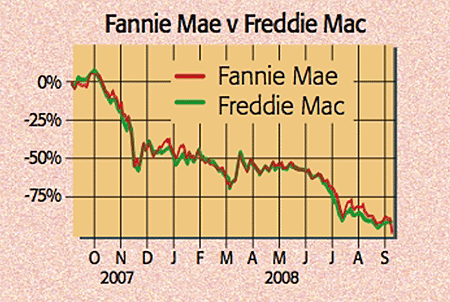
“Government intervention in the mechanics of free markets doesn’t come any bigger than this,” said Jeremy Warner in The Independent. America launched the biggest corporate rescue in history this week by effectively nationalising mortgage giants Fannie Mae and Freddie Mac. These two institutions are crucial to the US housing market. They buy up mortgage loans from lenders, package them up and sell them to investors, freeing up lenders to write more mortgages. They raise cash by selling shares and bonds, and can borrow cheaply, thanks to an implicit government guarantee. This helps explain how these Government Sponsored Enterprises (GSEs) expanded to the point where they own or guarantee almost half of America’s $12trn in mortgage debt – potential liabilities that will now officially be on the government balance sheet.
The rescue plan will see the two firms placed in “conservatorship”, a kind of temporary receivership, with the Treasury giving them access to a short-term credit facility and injecting the capital required to keep them above water by buying preferred stock; this facility has a capacity of up to $100bn each. The government will also purchase Fannie and Freddie’s mortgage-backed paper in the open market.
Why the government acted
There was no alternative to the rescue, said Martin Wolf in the FT. Fannie and Freddie couldn’t raise the capital they needed to offset losses on loans in the collapsing housing market. Dwindling confidence in the institutions threatened their access to finance and would have “drastically curtailed” their lending, which comprised more than 80% of American housing finance this year. “The whole mortgage market could well have collapsed,” said Richard Beales and Edward Hadas on Breakingviews. Moreover, Fannie’s and Freddie’s debt was widely distributed among foreign governments and central banks. Failure to guarantee these liabilities could have triggered a massive sell-off of their debt and a run on the dollar.
What next?
The ultimate cost of this rescue is “unknown and potentially huge”, said The Economist. It will depend on the GSEs’ ability to recover, but they are currently virtually insolvent, while house prices are still sliding and foreclosures rising. Higher government debt as a result of the bail-out implies higher bond yields, said ES Browning in The Wall Street Journal. This could put upward pressure on mortgage rates, as they are affected by bond yields – negating some of the expected decline in mortgage rates now that the GSEs have been stabilised.
This latest government rescue has further diminished America’s moral authority on economic affairs; “why should French farmers… take US promotion of the miracle of the market seriously?” asked Mike Prest on Breakingviews. One unintended consequence of the move, then, is “increasingly fettered markets”.
Nice work…
Shareholders are likely to lose everything, but the departing CEOs of Fannie and Freddie are doing fine. Fannie’s Daniel Mudd is in line for $9.3m in severance pay, retirement benefits and deferred compensation. Freddie’s Richard Syron’s exit package could be at least $14.1m, due largely to a clause added to his contract in July as Freddie’s problems worsened, says Eric Dash in the International Herald Tribune.